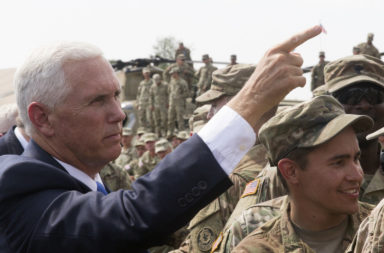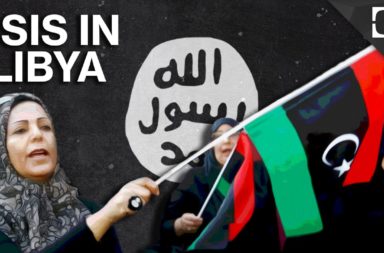There is a very real case for taking violent Islamic extremism far more seriously as a global threat, and for taking stronger measures to fight it. The United States was far too slow to react to the threat that ISIS and other violent Islamist extremist movements pose in Iraq and Syria, Yemen, Libya, and throughout much of the world.
There is also a strong case for better vetting procedures—as much because these procedures fail to quickly admit refugees, citizens of foreign countries who have actively supported the United States in war, and students—all of whom can become the strongest future voices for moderation and the true core of Islam in their countries—as well as the need to do everything possible to limit the entry of extremists and terrorists.
Rushing out an Executive Order that not only randomly discriminates against the citizens of seven countries, but also gives the impression of discriminating against all Muslims, however, does nothing to aid the real fight against Islamic extremism and terrorism. Doing so in a way where the draft was rushed out without coordination with General James Mattis, the new Secretary of Defense or General John F. Kelly, the new head of the Department of Homeland Security, almost certainly made things worse. General Mattis and General Kelly may be new to office, but they would have recognized that the battle against Islamic extremism cannot be won at the borders of the United States or Europe, but only in partnership with Muslim states and by keeping the support of the vast majority of the world’s Muslims.
These partnerships are critical. They keep the fight largely outside the United States. They affect key strategic interests throughout the Middle East and Asia. They also affect the grim humanitarian reality that something like 1.6 billion Muslims are threatened by a tiny minority of extremists, and that virtually all of the casualties involved are ordinary Muslims being killed by this minority of Muslim extremist.
Everyone involved in drafting this order—with any experience in the issue at all—should also have recognized at the start that implementing it without regard to people in transit, to their Green Card status, to their prior vetting and waiting time, and without offering clear alternatives for those already in process would produce a global public relations disaster.
Quite aside from the very real human rights and legal issues involved in the United States, the result has been a firestorm of criticism and anger overseas. It has alienated Muslims all over the world in precisely the way that ISIS and al Qaeda have been seeking to do for years. It has not communicated strength or legitimate purpose. It has sent a message that that the United States is the center of fear, prejudice, and hatred against all Muslims.
In the short term, it has blocked the flow of students, scholars, businessmen, officials, and ex-employees of the U.S. military and State Department from seven countries that are the epicenter of the U.S. effort to defeat Islamic extremism in the field—Iran, Iraq, Libya, Somalia, Sudan, Syria and Yemen.
Two of these countries—Iraq and Syria—are countries where the United States is actively partnered with largely Muslim forces in the field in fighting ISIS. Three more—Libya, Somalia, and Yemen—are countries where the United States plays a limited combat or security role and desperately needs local partners. A sixth—Iran—is a country where the United States has a critical need to do everything possible to encourage a moderate opposition and counter the very different kind of extremism coming out of its Supreme Leader and Revolutionary Guards.
The Executive Order also is not simply an issue of a 90-day ban. Its full text comes close to implying that all Muslim countries are the source of “those who engage in acts of bigotry or hatred (including “honor” killings, other forms of violence against women, or the persecution of those who practice religions different from their own) or those who would oppress Americans of any race, gender, or sexual orientation.” [i] It also calls for a review of all aspects of immigration and entry, calling for “the Secretary of Homeland Security’s determination of the information needed for adjudications and a list of countries that do not provide adequate information, within 30 days of the date of this order.”
It says the Secretary of Homeland Security “shall provide a copy of the report to the Secretary of State and the Director of National Intelligence,” but does not call for consultation or an agreed report or mention the Secretary of Defense—the key voices that understand the importance of strategic partnership with Muslim states throughout the world. These nations are critical partners in dealing with the fight against extremism and/or Iran, and they include Egypt, Jordan, Kuwait, Lebanon, Morocco, Oman, Qatar, Saudi Arabia and the UAE—not to mention Afghanistan—an almost completely Muslim state where we are again at war. The Executive Order also calls for new versions of this report after 60 days, 90 days, and 120 days—a recipe for at least six months of unstable U.S. policy and rules.
Perhaps because of rushed drafting and poor editing, the Executive Order calls for another series of seemingly duplicative reports: “The Secretary of Homeland Security, in conjunction with the Secretary of State, the Director of National Intelligence, and the Director of the Federal Bureau of Investigation, shall submit to the President an initial report on the progress of this directive within 60 days of the date of this order, a second report within 100 days of the date of this order, and a third report within 200 days of the date of this order.”
The full text of the order also makes it clear that the 90-day ban and present list of countries could change to include more countries and extend far longer. The Secretary of Homeland Security is directed to recommend a more permanent list within 60 days—again without clear instruction to coordinate with other key Departments—”of countries recommended for inclusion on a Presidential proclamation that would prohibit the entry of foreign nationals (excluding those foreign nationals traveling on diplomatic visas, North Atlantic Treaty Organization visas, C-2 visas for travel to the United Nations, and G-1, G-2, G-3, and G-4 visas) from countries that do not provide the information requested pursuant to subsection (d) of this section until compliance occurs.”
The Executive Order dodges around openly stating that it gives a post 90-day priority to Christians over Muslims with a text that says, “Upon the resumption of USRAP [United States Refugee Admissions Program] admissions, the Secretary of State, in consultation with the Secretary of Homeland Security, is further directed to make changes, to the extent permitted by law, to prioritize refugee claims made by individuals on the basis of religious-based persecution, provided that the religion of the individual is a minority religion in the individual’s country of nationality. Where necessary and appropriate, the Secretaries of State and Homeland Security shall recommend legislation to the President that would assist with such prioritization.” This dodging, however, has not gone unnoticed in any largely Muslim country, and its net effect is going to be to single out the native Christians who both plan to leave and the native Christians who plan to stay, as targets for extremists, rather than help them.
It also plays to local politics and prejudices by stating that, “It is the policy of the executive branch that, to the extent permitted by law and as practicable, State and local jurisdictions be granted a role in the process of determining the placement or settlement in their jurisdictions of aliens eligible to be admitted to the United States as refugees.” This may help in the best of cases. Given local prejudices, there will be many worst cases as well. Each will be become another propaganda tool and political weapon in the hands of movements like ISIS and al Qaeda.
Some good measures—like better biometrics — are called for, but they may now be buried in the Executive Order’s many mistakes: “The Secretary of Homeland Security shall expedite the completion and implementation of a biometric entry-exit tracking system for all travelers to the United States, as recommended by the National Commission on Terrorist Attacks Upon the United States…The Secretary of Homeland Security shall submit to the President periodic reports on the progress of the directive contained in subsection (a) of this section. The initial report shall be submitted within 100 days of the date of this order, a second report shall be submitted within 200 days of the date of this order, and a third report shall be submitted within 365 days of the date of this order. Further, the Secretary shall submit a report every 180 days thereafter until the system is fully deployed and operational.”
Other details, however, will be a nightmare. Calling for extreme vetting of foreign nationals from nations in crisis or civil war is mission impossible. Focusing on the cost of vetting, rather than the rights of the vetted, makes things worse. One such step is to “immediately suspend the Visa Interview Waiver Program and ensure compliance with section 222 of the INA, 8 U.S.C. 1222, which requires that all individuals seeking a nonimmigrant visa undergo an in-person interview, subject to specific statutory exceptions”—long before enough qualified personnel will be available to handle the existing interview system.
Another is to impose a vague, open-ended new requirement that, “If a country does not treat United States nationals seeking nonimmigrant visas in a reciprocal manner, the Secretary of State shall adjust the visa validity period, fee schedule, or other treatment to match the treatment of United States nationals by the foreign country, to the extent practicable.”
There also is an acute danger in imposing a reporting requirement that only focuses on the threat posed by foreign nationals, instead of the far larger role played in terrorist attacks by native born or immigrant U.S. citizens already in the United States. The Executive Order states:
To be more transparent with the American people, and to more effectively implement policies and practices that serve the national interest, the Secretary of Homeland Security, in consultation with the Attorney General, shall, consistent with applicable law and national security, collect and make publicly available within 180 days, and every 180 days thereafter:
(i) information regarding the number of foreign nationals in the United States who have been charged with terrorism-related offenses while in the United States; convicted of terrorism-related offenses while in the United States; or removed from the United States based on terrorism-related activity, affiliation, or material support to a terrorism-related organization, or any other national security reasons since the date of this order or the last reporting period, whichever is later;
(ii) information regarding the number of foreign nationals in the United States who have been radicalized after entry into the United States and engaged in terrorism-related acts, or who have provided material support to terrorism-related organizations in countries that pose a threat to the United States, since the date of this order or the last reporting period, whichever is later; and
(iii) information regarding the number and types of acts of gender-based violence against women, including honor killings, in the United States by foreign nationals, since the date of this order or the last reporting period, whichever is later; and
(iv) any other information relevant to public safety and security as determined by the Secretary of Homeland Security and the Attorney General, including information on the immigration status of foreign nationals charged with major offenses.
(b) The Secretary of State shall, within one year of the date of this order, provide a report on the estimated long-term costs of the USRAP at the Federal, State, and local levels.
Here, it is critical to understand that the Executive Order seems to be based on the assumption that the primary threat to the United States will come from given countries and from the outside. Since 9/11, there have been some 400 individuals charged with some form of Islamic extremist or Jihadist activity in the United States, and imposing new quotas of refugees will somehow reduce the already limited outside threat to the United States. As a recent report in the Washington Post indicates, 82% were native born or already were permanent residents. A total of 190 were U.S. citizens born in the United States. Another 82 were naturalized citizens, and 44 more were already permanent residents. Out of the rest, 11 were citizens of unknown status, all of 12 were refugees, 11 had non-immigrant visas and 8 were illegal immigrants. The Executive Order would at best affect 21% of the total— assuming that terrorist and extremist groups could create a new flow of illegal immigrants, recruit from other countries, and use such Executive Orders to provoke more U.S. prejudice and fear. [ii]
As for the Muslim Americans involved, it is equally important to keep them in perspective, and avoid the kind of prejudice and gear that led to discrimination and attacks on immigrants from Germany and Italy in World War II, the deportation of innocent immigrants to Russia after the Communist takeover at the end of World War II, blocking Jewish refugees before World War II, and interning innocents Japanese during World War II. Here a new report by Charles Kurzman of the Department of Sociology, University of North Carolina, Chapel Hill, sounds a clear warning: [iii]
Forty-six Muslim-Americans were associated with violent extremism in 2016, a 40 percent drop from 2015 but higher than the annual average since 9/11 (27 per year, for a total of 414 over more than 15 years). Almost half of the individuals identified in 2016 traveled (8 individuals) or attempted to travel (14 individuals) to join militant groups overseas. Twenty-three individuals were associated with plots against targets in the United States, and one case involved an unknown target )…
Few of these individuals (9 of 46, or 20 percent) had family backgrounds from the seven countries reportedly designated by the Trump administration for temporary immigration bans. Since 9/11, only 23 percent of Muslim-Americans involved with violent extremist plots had family backgrounds in these seven countries (Iraq, Iran, Libya, Somali, Sudan, Syria, Yemen). There have been no fatalities in the United States caused by extremists with family backgrounds in these countries.
The plots in 2016 were overshadowed by a single attack, the mass shooting at a nightclub in Orlando, Florida, on June 12, 2016, in which 49 people were killed, plus the shooter, and 53 were injured. This was the deadliest terrorist attack in the United States since September 11, 2001, when approximately three thousand were killed. Five other attacks in 2016 accounted for five additional deaths, plus two of the attackers, and 53 injuries. The 54 fatalities caused by Muslim-American extremists in 2016 brought the total since 9/11 to 123. More than 240,000 Americans were murdered over the same period.1 In 2016 alone, 188 Americans were killed in mass shootings.2 This figure does not include the victims of Muslim-American extremists.
Grossly overreacting to a tiny minority that poses a comparatively tiny threat is a classic case letting “fear itself” take over from common sense. If we need anything like a war against Islamic extremism—and war may be far too dramatic a title—we need to keep the vast majority of Muslims and Muslim states as partners. We need to fight outside our own territory as much as possible. We need to avoid becoming the enemy of Muslims that ISIS and al Qaeda try to portray us as, and we need to recognize that ultimately victory will be based on the common perception that the mainstream of Judaism, Christianity, and Islam share the same core values.
Anthony H. Cordesman holds the Arleigh A. Burke Chair in Strategy at the Center for Strategic and International Studies (CSIS) in Washington, D.C.




